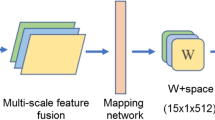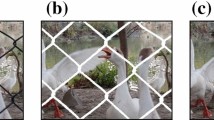Abstract
To enhance the appeal of residential real estate listings and captivate online customers, clean and visually convincing indoor scenes are highly desirable. In this research, we introduce an innovative image inpainting model designed to seamlessly replace undesirable elements within images of indoor residential spaces with realistic and coherent alternatives. While Generative Adversarial Networks (GANs) have demonstrated remarkable potential for removing unwanted objects, they can be resource-intensive and face difficulties in consistently producing high-quality outcomes, particularly when unwanted objects are scattered throughout the images. To empower small- and medium-sized businesses with a competitive edge, we present a novel GAN model that is resource-efficient and requires minimal training time using arbitrary mask generation and a novel half-perceptual loss function. Our GAN model achieves compelling results in removing unwanted elements from indoor scenes, demonstrating the capability to train within a single day using a single GPU, all while minimizing the need for extensive post-processing.













Similar content being viewed by others
Data availability
The datasets generated and/or analyzed during the current study are from https://unsplash.com, https://www.pexels.com, https://pixabay.com, and the LSUN dataset [23]. They are available from the corresponding author upon reasonable request.
References
The total value of global real estate (2021) Savills. Retrieved March 27, 2022, from https://www.savills.com/impacts/market-trends/the-total-value-of-global-real-estate.html
Zhang S, Lee D, Singh PV, Srinivasan K (2022) What makes a good image? Airbnb demand analytics leveraging interpretable image features. Manag Sci 68(8):5644–5666
Goodfellow IJ, Pouget-Abadie J, Mirza M, Xu B, Warde-Farley D, Ozair S, Courville AC, Bengio Y (2014) Generative adversarial nets. In Neural Inform Process Syst (NIPS). pp 2672–2680
Gui J, Sun Z, Wen Y, Tao D, Ye J (2021) A review on generative adversarial networks: Algorithms, theory, and applications. IEEE Trans Knowl Data Eng 35(4):3313–3332
Eilertsen G, Tsirikoglou A, Lundström CF, Unger J (2021) Ensembles of GANs for synthetic training data generation. In Int Conf Learn Representations (ICLR) Workshop on Synthetic Data Generation: Quality, Privacy, Bias. https://iclr.cc/virtual/2021/3699
Radford A, Metz L, Chintala S (2016) Unsupervised representation learning with deep convolutional generative adversarial networks. In Int Conf Learn Representations (ICLR)
Karras T, Aila T, Laine S, Lehtinen J (2018) Progressive growing of GANs for improved quality, stability, and variation. In Int Conf Learn Representations (ICLR). pp 1–26
Jin Y, Zhang J, Li M, Tian Y, Zhu H, Fang Z (2017) Towards the automatic anime characters creation with generative adversarial networks. Arxiv abs/1708.05509
Angkawinijwong S, Chootai P, Chuenphitthayavut K, Narksenee T, Siriborvornratanakul S (2023) Generative adversarial network for DOTA2 character generation. J Appl Sci Emerg Technol (JASET) 22(2):1
Isola P, Zhu J, Zhou T, Efros AA (2017) Image-to-image translation with conditional adversarial networks. In IEEE Conference on Computer Vision and Pattern Recognition (CVPR). pp 5967–5976
Zhu J, Park T, Isola P, Efros AA (2017) Unpaired image-to-image translation using cycle-consistent adversarial networks. In IEEE International Conference on Computer Vision (ICCV). pp 2242–2251
Nazeri K, Ng E, Joseph T, Qureshi F, Ebrahimi M (2019) EdgeConnect: structure guided image inpainting using edge prediction. In IEEE/CVF International Conference on Computer Vision Workshops (ICCVW)
Yu J, Lin ZL, Yang J, Shen X, Lu X, Huang TS (2018) Generative image inpainting with contextual attention. In IEEE/CVF Conference on Computer Vision and Pattern Recognition (CVPR), pp 5505–5514
Yu J, Lin ZL, Yang J, Shen X, Lu X, Huang TS (2019) Free-form image inpainting with gated convolution. In IEEE/CVF International Conference on Computer Vision (ICCV), pp 4470–4479
Ruzic T, Pižurica A (2015) Context-aware patch-based image inpainting using Markov random field modelling. IEEE Trans Image Process 24(1):444–456
Amrani N, Serra-Sagristà J, Peter P, Weickert J (2017) Diffusion-based inpainting for coding remote-sensing data. IEEE Geosci Remote Sens Lett 14(8):1203–1207
Yan Z, Li X, Li M, Zuo W, Shan S (2018) Shift-Net: Image inpainting via deep feature rearrangement. In European Conference on Computer Vision (ECCV), pp 3–19
Pathak D, Krähenbühl P, Donahue J, Darrell T, Efros AA (2016) Context encoders: feature learning by inpainting. In IEEE Conference on Computer Vision and Pattern Recognition (CVPR), pp 2536–2544
Iizuka S, Simo-Serra E, Ishikawa H (2017) Globally and locally consistent image completion. ACM Trans Graph (TOG) 36(4):1–14
Wang T, Ouyang H, Chen Q (2021) Image inpainting with external-internal learning and monochromic bottleneck. In IEEE/CVF Conference on Computer Vision and Pattern Recognition (CVPR), pp 5116–5125
Liu G, Reda FA, Shih KJ, Wang TC, Tao A, Catanzaro B (2018) Image inpainting for irregular holes using partial convolutions. In European Conference on Computer Vision (ECCV), pp 85–100
Zhao S, Cui J, Sheng Y, Dong Y, Liang X, Chang EI, Xu Y (2021) Large scale image completion via co-modulated generative adversarial networks. In International Conference on Learning Representations (ICLR). pp 1–25
Yu F, Seff A, Zhang Y, Song S, Funkhouser T, Xiao J (2015) LSUN: construction of a large-scale image dataset using deep learning with humans in the loop. arXiv:1506.03365 [cs.CV]
Tseng CW, Lin H, Lai S (2017) General deep image completion with lightweight conditional generative adversarial networks. In British Machine Vision Conference (BMVC)
Simonyan K, Zisserman A (2015) Very deep convolutional networks for large-scale image recognition. In International Conference on Learning Representations (ICLR). pp 1–14
Clevert D, Unterthiner T, Hochreiter S (2016) Fast and accurate deep network learning by exponential linear units (ELUs). In International Conference on Learning Representations (ICLR)
Gentile C, Warmuth MK (1998) Linear hinge loss and average margin. In Neural Information Processing Systems (NIPS), pp 225–231
Zhao H, Gallo O, Frosio I, Kautz J (2017) Loss functions for image restoration with neural networks. IEEE Trans Comput Imaging 3(1):47–57
Horé A, Ziou D (2010) Image quality metrics: PSNR vs. SSIM. In International Conference on Pattern Recognition (ICPR), pp 2366–2369
Chong MJ, Forsyth DA (2020) Effectively unbiased fid and inception score and where to find them. In IEEE/CVF Conference on Computer Vision and Pattern Recognition (CVPR), pp 6069–6078
Johnson J, Alahi A, Fei-Fei L (2016) Perceptual losses for real-time style transfer and super-resolution. In European Conference on Computer Vision (ECCV), pp 694–711
Gatys LA, Ecker AS, Bethge M (2016) Image style transfer using convolutional neural networks. In IEEE Conference on Computer Vision and Pattern Recognition (CVPR), pp 2414–2423
Suvorov R, Logacheva E, Mashikhin A, Remizova A, Ashukha A, Silvestrov A, Kong N, Goka H, Park K, Lempitsky VS (2022) Resolution-robust large mask inpainting with fourier convolutions. In IEEE/CVF Winter Conference on Applications of Computer Vision (WACV), pp 3172–3182
Mao X, Li Q, Xie H, Lau RY, Wang Z, Smolley SP (2017) Least squares generative adversarial networks. In IEEE International Conference on Computer Vision (ICCV), pp 2813–2821
Zhao H, Shi J, Qi X, Wang X, Jia J (2017) Pyramid scene parsing network. In IEEE Conference on Computer Vision and Pattern Recognition (CVPR), pp 6230–6239
Funding
The authors did not receive support from any organization for the submitted work.
Author information
Authors and Affiliations
Contributions
All authors contributed to this article equally.
Corresponding author
Ethics declarations
Conflicts of interest
The authors have no conflicts of interest to declare that are relevant to the content of this article.
Additional information
Publisher's Note
Springer Nature remains neutral with regard to jurisdictional claims in published maps and institutional affiliations.
Rights and permissions
Springer Nature or its licensor (e.g. a society or other partner) holds exclusive rights to this article under a publishing agreement with the author(s) or other rightsholder(s); author self-archiving of the accepted manuscript version of this article is solely governed by the terms of such publishing agreement and applicable law.
About this article
Cite this article
Sompoppokasest, S., Siriborvornratanakul, T. A lightweight image inpainting model for removing unwanted objects from residential real estate’s indoor scenes. Multimed Tools Appl (2024). https://doi.org/10.1007/s11042-024-18605-1
Received:
Revised:
Accepted:
Published:
DOI: https://doi.org/10.1007/s11042-024-18605-1




